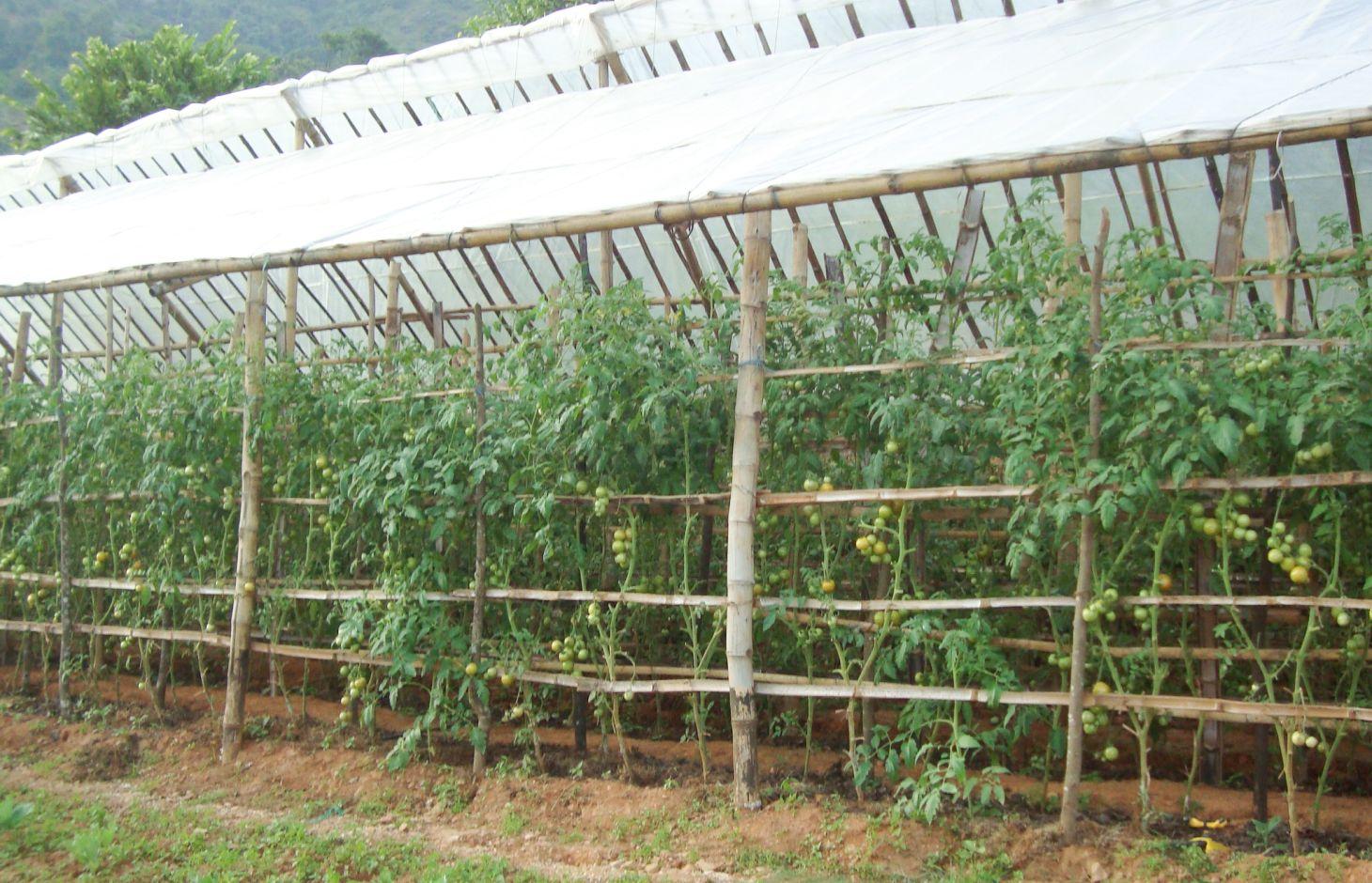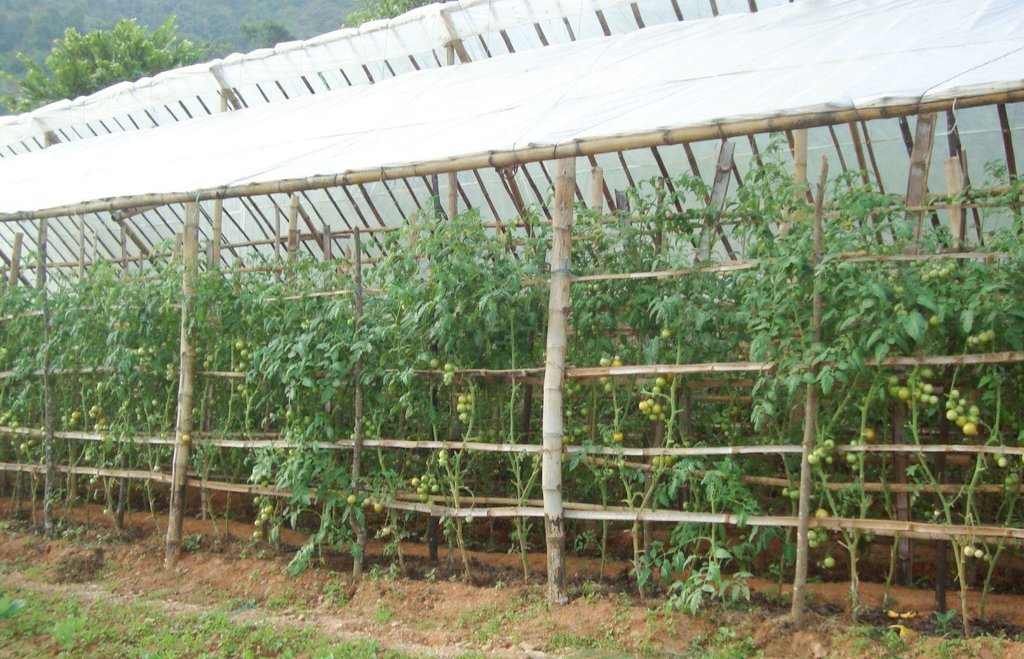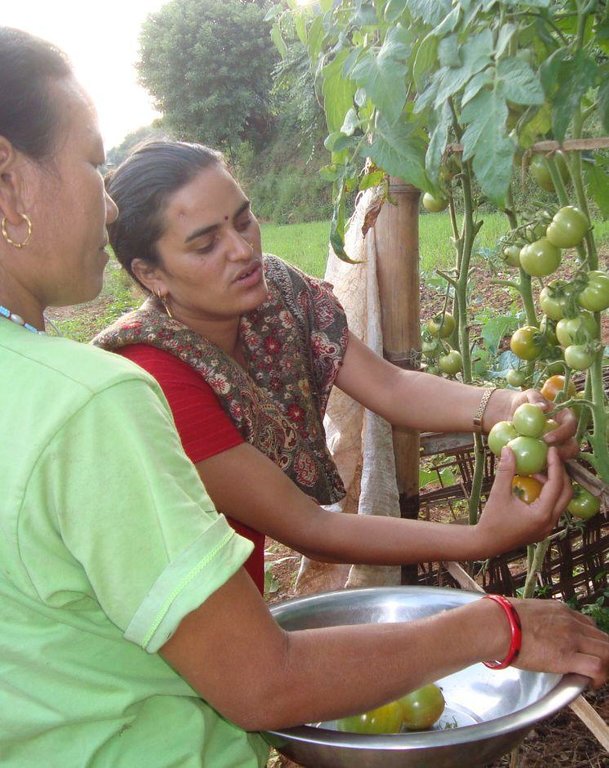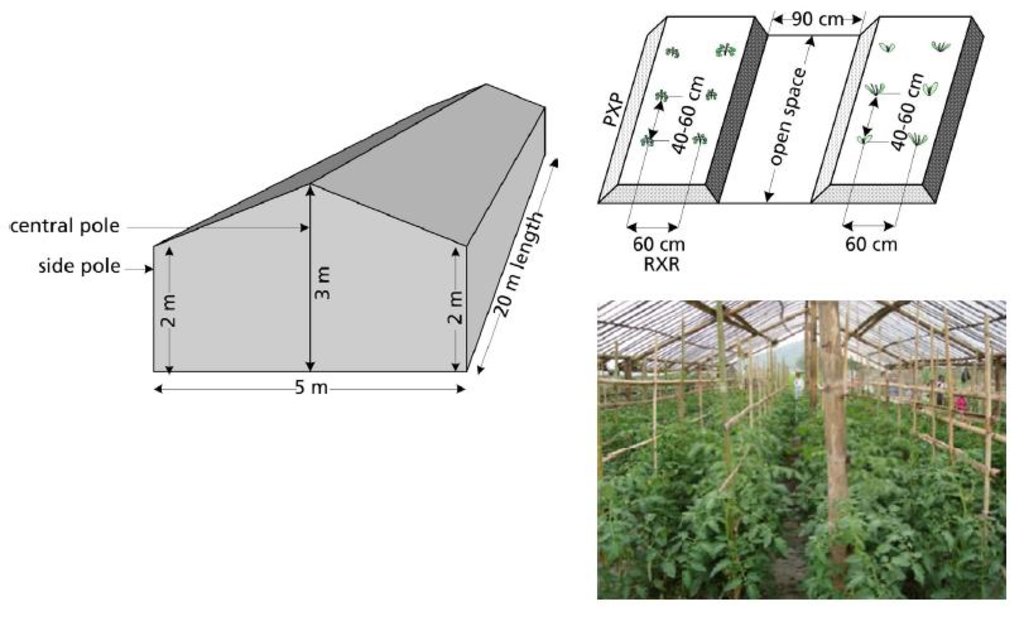A low-cost polyhouse for tomato production in the rainy season [尼泊尔]
- 创建:
- 更新:
- 编制者: Shreedip Sigdel
- 编辑者: –
- 审查者: David Streiff, Alexandra Gavilano
Sasto Plastic ghar ma barsha golbheda kheti (Main Contributor: Bishnu Bishwakarma, Helvetas Nepal)
technologies_1688 - 尼泊尔
查看章节
全部展开 全部收起1. 一般信息
1.2 参与该技术评估和文件编制的资源人员和机构的联系方式
土地使用者:
有助于对技术进行记录/评估的机构名称(如相关)
HELVETAS (Swiss Intercooperation)有助于对技术进行记录/评估的机构名称(如相关)
ICIMOD International Centre for Integrated Mountain Development (ICIMOD) - 尼泊尔1.3 关于使用通过WOCAT记录的数据的条件
编制者和关键资源人员接受有关使用通过WOCAT记录数据的条件。:
是
2. SLM技术的说明
2.1 技术简介
技术定义:
Smallholder farmers can use polyhouses to produce high demand vegetables, such as tomatoes, and can earn a substantial income from even a relatively small plot of land in a short time.
2.2 技术的详细说明
说明:
During the wet season (June–October), the monsoon rains severely limit the type of crops that can be grown in open fields and they also restrict the production of seedlings. Low-cost polyhouses can be used to protect crops from excessive rainfall and can provide a sheltered environment for the production of better quality crops over the rainy season cropping period. For example, smallholder farmers who produce high demand vegetables such as tomatoes can earn as much as USD 350–500 from a plot of land which measures only 100 m2 in area over the short time period from June to November. This is much more than they can earn by growing any traditional crop by conventional methods. The Sustainable Soil Management Programme (SSMP) is promoting this technology in several mid-hill districts of Nepal.
Establishment / maintenance activities and inputs: Polyhouses should be situated in well-drained areas where sunshine is abundant and there is no shade throughout the cropping period. The bamboo frame can be constructed earlier in the year but the plastic roofing is not added until after one or two rainfall events. The height of the polyhouse frame varies depending on the altitude. At higher elevations, the polyhouses are lower to help trap more heat and moisture, whereas at lower elevations the polyhouses are higher to allow more air to circulate and moisture to evaporate. The preparations, which take place mid-May to early June, consist of fertilizing the soil and planting the tomato seedlings. Throughout the growing season the tomato plants are staked, trained, and pruned and a top dressing of fertilizer is added to produce a higher quality product.
2.3 技术照片
2.5 已应用该技术的、本评估所涵盖的国家/地区/地点
国家:
尼泊尔
有关地点的进一步说明:
Mid Hills of Nepal
具体说明该技术的分布:
- 均匀地分布在一个区域
如果不知道精确的区域,请注明大致覆盖的区域:
- 1-10 平方千米
2.7 技术介绍
详细说明该技术是如何引入的:
- 通过项目/外部干预
3. SLM技术的分类
3.1 该技术的主要目的
- 改良生产
- 创造有益的经济影响
3.2 应用该技术的当前土地利用类型

农田
- 一年一作
- tomatoes
每年的生长季节数:
- 1
具体说明:
Longest growing period in days: 214; Longest growing period from month to month: May to November
注释:
Major land use problems (compiler’s opinion): In the mid-hills of Nepal, the arable land of most farm households has been divided into very small plots. If this land is used to produce traditional crops such as maize, wheat, and millet using conventional farming methods, it cannot provide full employment for all of the householders and cannot yield sufficient cash income for the household. The risk of intense rainfall during the monsoon season, which can damage crops, has prevented these farmers from switching to more lucrative high value crops.
3.5 该技术所属的SLM组
- Greenhouses
3.6 包含该技术的可持续土地管理措施

农艺措施
- A7:其它
3.7 该技术强调的主要土地退化类型

土壤水蚀
- Wt:表土流失/地表侵蚀
注释:
Main causes of degradation: Heavy / extreme rainfall (intensity/amounts) (During the summer monsoon (June-October), continuous or heavy rainfall can damage seedlings and erode the land; it is difficult to establish crops during this time.)
3.8 防止、减少或恢复土地退化
具体数量名该技术与土地退化有关的目标:
- 防止土地退化
4. 技术规范、实施活动、投入和成本
4.1 该技术的技术图纸
技术规范(与技术图纸相关):
Left: Sketch of a polyhouse. The optimum length is 20 m and the width 5 m. The height of the central and side poles varies depending on the elevation. Note that there should be a space of at least 1 m between polyhouses.
Right top: Cross sectional view of a planting bed showing row-to-row (RXR) and plant-to-plant (PXP) distances. Note that there should be a space of at least 90 cm between beds.
Right bottom: Inside the polyhouse, the tomatoes can be staked using bamboo poles; the plants are trained along these trellises.
Technical knowledge required for land users: moderate
Main technical functions: Increase Productivity, Introduce high value crop
Secondary technical functions: increase in nutrient availability (supply, recycling,…)
作者:
AK Thaku
4.2 有关投入和成本计算的一般信息
具体说明成本和投入是如何计算的:
- 每个技术单元
指定单位:
Polyhouse
具体说明成本计算所用货币:
- 美元
注明雇用劳工的每日平均工资成本:
4
4.3 技术建立活动
| 活动 | 时间(季度) | |
|---|---|---|
| 1. | Labour for construction of the Polyhouse | |
| 2. | Labour for planting, training,pruning,stalking | |
| 3. | Materials: Bamboo pole, plastics sheet, rope, nails, seed, poles | |
| 4. | Agricultural: seed, fertilizer, crop protection |
注释:
Details for the establishment of Poly house. Establishment activities 1. Construction of the polyhouse using bamboo poles, wooden posts, clear plastic sheet, nails, and rope. 2. How long it takes to construct the polyhouse and plant the crops depends on how much labour is available. Depending on their level of expertise, four to five people can construct the structure in one day; and two people can complete the soil preparation and planting in one day. Technical guidelines for erecting a polyhouse The optimum length of a polyhouse is 20 m, and the width is 5 m; 400–500 gauge plastic sheeting is used. The height of the polyhouse depends on the elevation: at 1200–1600 masl, the optimum height of the central pole is 3 m and the side poles are 2 m high; at 1600–2000 masl, the central pole is 2.5 m high and the side poles are 1.6 m high. There should be an open space of at least 1 m between polyhouses. Technical guidelines for preparing the soil and planting tomatoes Per plant, at least 3–4 kg of well-decomposed farmyard manure and compost are worked into the soil. Before transplanting the seedlings, the soil around each is dressed with 10 g of DAP (diammonium phosphate) and 6 g of MoP (muriate of potash). The seedlings are transplanted when they are 20–25 days old. In an open row system, the suggested row to row (RxR) spacing is 90 cm and the suggested plant to plant (PxP) spacing is 60 cm; in a closed row system the row to row and plant to plant spacing can both be 60 cm. At least two top dressings of DAP and MoP (10:10 g) are necessary 20–25 and 40–45 days after transplanting; 1 kg per 0.05 ha of borax is also added at the time of the first top dressing. Alternatively, these two top dressings can be substituted by a mixture of cattle urine (50 ml) and water (200 ml water) per plant. The dressing with this mixture can begin 20–25 days after transplanting, and is repeated every 10–12 days.
4.4 技术建立所需要的费用和投入
| 对投入进行具体说明 | 单位 | 数量 | 单位成本 | 每项投入的总成本 | 土地使用者承担的成本% | |
|---|---|---|---|---|---|---|
| 劳动力 | Construction of the polyhouse | persons/unit | 5.0 | 4.0 | 20.0 | 100.0 |
| 劳动力 | Training, pruning, stalking | persons/unit | 5.0 | 4.0 | 20.0 | 100.0 |
| 植物材料 | Seed, fertilizer, crop protection | unit | 1.0 | 10.0 | 10.0 | 50.0 |
| 施工材料 | Bamboo pole, plastics sheet, rope, nails, seed, poles | unit | 1.0 | 90.0 | 90.0 | 35.0 |
| 技术建立所需总成本 | 140.0 | |||||
| 技术建立总成本,美元 | 140.0 | |||||
4.5 维护/经常性活动
| 活动 | 时间/频率 | |
|---|---|---|
| 1. | There are no major maintenance costs during the cropping season; but occasionally some minor maintenance is required (e.g., replacing damaged stakes and plastic sheet, or securing with additional rope and nails). |
4.6 维护/经常性活动所需要的费用和投入(每年)
| 对投入进行具体说明 | 单位 | 数量 | 单位成本 | 每项投入的总成本 | 土地使用者承担的成本% | |
|---|---|---|---|---|---|---|
| 劳动力 | Maintenance | persons/unit | 1.0 | 5.0 | 5.0 | 100.0 |
| 设备 | Equipment | unit | 1.0 | 5.0 | 5.0 | 100.0 |
| 肥料和杀菌剂 | Agricultural | unit | 1.0 | 5.0 | 5.0 | 100.0 |
| 施工材料 | Material | unit | 1.0 | 10.0 | 10.0 | 100.0 |
| 技术维护所需总成本 | 25.0 | |||||
| 技术维护总成本,美元 | 25.0 | |||||
4.7 影响成本的最重要因素
描述影响成本的最决定性因素:
All costs and amounts are rough estimates by the technicians and authors. Exchange rate USD 1 = NPR 71 in April 2011
5. 自然和人文环境
5.1 气候
年降雨量
- < 250毫米
- 251-500毫米
- 501-750毫米
- 751-1,000毫米
- 1,001-1,500毫米
- 1,501-2,000毫米
- 2,001-3,000毫米
- 3,001-4,000毫米
- > 4,000毫米
有关降雨的规范/注释:
Annual rainfall: Also 1000-1500 mm and 1500-2000 mm
农业气候带
- 潮湿的
Thermal climate class: subtropics
5.2 地形
平均坡度:
- 水平(0-2%)
- 缓降(3-5%)
- 平缓(6-10%)
- 滚坡(11-15%)
- 崎岖(16-30%)
- 陡峭(31-60%)
- 非常陡峭(>60%)
地形:
- 高原/平原
- 山脊
- 山坡
- 山地斜坡
- 麓坡
- 谷底
垂直分布带:
- 0-100 m a.s.l.
- 101-500 m a.s.l.
- 501-1,000 m a.s.l.
- 1,001-1,500 m a.s.l.
- 1,501-2,000 m a.s.l.
- 2,001-2,500 m a.s.l.
- 2,501-3,000 m a.s.l.
- 3,001-4,000 m a.s.l.
- > 4,000 m a.s.l.
关于地形的注释和进一步规范:
Slopes on average: Also moderate (6-10%), rolling (11-15%) and hilly (16-30%)
Landforms: Also footslopes
5.3 土壤
平均土层深度:
- 非常浅(0-20厘米)
- 浅(21-50厘米)
- 中等深度(51-80厘米)
- 深(81-120厘米)
- 非常深(> 120厘米)
土壤质地(表土):
- 中粒(壤土、粉土)
表土有机质:
- 高(>3%)
- 中(1-3%)
如有可能,附上完整的土壤描述或具体说明可用的信息,例如土壤类型、土壤酸碱度、阳离子交换能力、氮、盐度等。:
Soil fertility is medium - high
Soil water storage capacity is medium - high
5.6 应用该技术的土地使用者的特征
生产系统的市场定位:
- 商业/市场
非农收入:
- 低于全部收入的10%
相对财富水平:
- 平均水平
个人或集体:
- 个人/家庭
机械化水平:
- 手工作业
- 畜力牵引
5.7 应用该技术的土地使用者使用的平均土地面积
- < 0.5 公顷
- 0.5-1 公顷
- 1-2 公顷
- 2-5公顷
- 5-15公顷
- 15-50公顷
- 50-100公顷
- 100-500公顷
- 500-1,000公顷
- 1,000-10,000公顷
- > 10,000公顷
5.8 土地所有权、土地使用权和水使用权
土地所有权:
- 个人,未命名
- 个人,有命名
土地使用权:
- 个人
用水权:
- 社区(有组织)
6. 影响和结论性说明
6.1 该技术的现场影响
社会经济效应
生产
生产故障风险
产品多样性
收入和成本
农业收入
收入来源的多样性
工作量
其它社会经济效应
Initial cost
Technical knowhow
社会文化影响
食品安全/自给自足
注释/具体说明:
Improved food security and reduced need for either seasonal migration or outside help
社会经济弱势群体的情况
livelihood and human well-being
生态影响
土壤
土壤流失
生物多样性:植被、动物
害虫/疾病控制
注释/具体说明:
Can be susceptible to some fungal diseases
减少气候和灾害风险
干旱影响
飓风、暴雨的影响
6.2 该技术的场外影响已经显现
Areas downstream benefit from soil retention
6.3 技术对渐变气候以及与气候相关的极端情况/灾害的暴露和敏感性(土地使用者认为的极端情况/灾害)
渐变气候
渐变气候
| 季节 | 增加或减少 | 该技术是如何应对的? | |
|---|---|---|---|
| 年温度 | 增加 | 不好 |
气候有关的极端情况(灾害)
气象灾害
| 该技术是如何应对的? | |
|---|---|
| 局地暴雨 | 好 |
其他气候相关的后果
其他气候相关的后果
| 该技术是如何应对的? | |
|---|---|
| High relative humidity | 不好 |
注释:
optimize the plant density; train and prune plants often to avoid overcrowding; modify the structure to provide more ventilation (ventilated polyhouse) in especially hot areas
6.4 成本效益分析
技术收益与技术建立成本相比如何(从土地使用者的角度看)?
短期回报:
积极
长期回报:
积极
技术收益与技术维护成本/经常性成本相比如何(从土地使用者的角度看)?
短期回报:
积极
长期回报:
积极
6.5 技术采用
注释:
There is a moderate trend towards spontaneous adoption of the Technology
Comments on adoption trend: Although the technology is only moderately expensive to implement and provides a higher rate of return than traditional crops, smallholder farmers often need technical support and encouragement to get started. This support can be in the form of improved seed varieties and plastic sheeting for the polyhouse.
Driver for adoption:
• relatively simple technology
• higher economic return
• provides on-farm employment
Constraints
• smallholder farmers and poorer households need initial support to establish the polyhouse
• farmers need technical support
• farmers need practical information and technical backstopping
6.7 该技术的优点/长处/机会
| 编制者或其他关键资源人员认为的长处/优势/机会 |
|---|
|
Cost effective in terms of output as compared to traditional crops How can they be sustained / enhanced? Identify other cash crops that can also provide improved income opportunities |
|
This technology can be integrated to make maximum use of farm niches; it is especially beneficial for smallholder farmers How can they be sustained / enhanced? Provide training on the construction of polyhouses to experienced lead farmers so that they can provide technical support to others. |
|
It mostly uses local materials How can they be sustained / enhanced? Ensure bamboo poles are available on the farm; encourage the use of silpaulin which is more durable than polyethylene |
|
Uses local expertise, farmer knowledge, and practices How can they be sustained / enhanced? Farmers can make the most of their investment by linking with markets and by providing support for value chain development. |
6.8 技术的弱点/缺点/风险及其克服方法
| 编制者或其他关键资源人员认为的弱点/缺点/风险 | 如何克服它们? |
|---|---|
| Need to provide training and technical know-how and need on-farm research to identify alternative cash crops | Farmer-to-famer extension can help to identify other crops |
| Vulnerable to diseases and pests | Adjust planting time to local conditions; build the polyhouses in appropriate locations; plant resistant varieties; modify the structure to improve air circulation; prune and train plants throughout the cropping season; improve staking techniques; rotate crops or move polyhouse every three years |
| Some initial set-up cost | Silpaulin can be purchased at lower cost when farmers' groups buy in bulk. |
7. 参考和链接
7.1 信息的方法/来源
7.2 参考可用出版物
标题、作者、年份、ISBN:
Construction of polyhouse and rainy season tomato cultivation inside polyhouse (in Nepali). Kathmandu, Nepal: Sustainable Soil Management Programme, Helvetas Nepal, SSMP (2010)
链接和模块
全部展开 全部收起链接
无链接
模块
无模块





